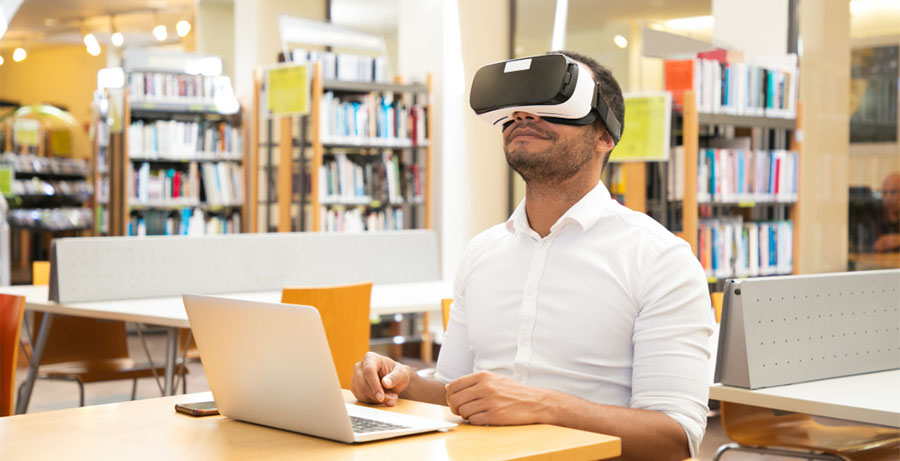“We’re finally going to be free of the 2D monitor. It’s been a window into virtual reality that we’ve all looked into for 30 or 40 years.
– Brendan Iribe”
Virtual Reality (VR) has the potential and power to take learning beyond the traditional online learning experience. You can now leave your textbooks in the drawer and video lectures aside for a virtual trip inside the human body to explore the circulatory system, or you can try to fix a car engine in a risk-free VR garage. This simulation-based technology can change how online training programs work. It can offer many benefits like better engagement, improved retention, and hands-on learning.
According to the National Institutes of Health, a study has shown how virtual reality (VR) can affect communication in healthcare. They used VR with two groups of medical students and surveyed them before and after. Results showed that VR helped students learn better and they were satisfied with it. 91% of the students agreed that integrating virtual reality into teaching and learning is important.
First thing First: What Is Online Learning And Its Features?
I will keep it simple for you, it is like learning something new, but instead of going to a classroom, you can do it from your favourite comfy sofa at home! That is the magic of online learning. Now you can enjoy the rainy view from your window while attending classes on your laptop. Doesn’t that sound soothing and relaxing? Now, let’s explore some of the key benefits of online learning.
-
Flexibility
You will be the one who makes the schedule according to your priorities. You can fit your learning around work, family, or that nap needed for a long time. These online courses let you learn at your own pace, whenever you have time.
-
Save Time and Money
This online learning mode will save you money on ravelling, parking, or maybe even that Starbucks coffee you grab on the way to class. Moreover, some online programs can be cheaper than traditional schooling.
-
Learn Anything, Anywhere
You can attend these classes anytime and anywhere in the world, you just need a mobile phone or laptop with internet connectivity. You will not be limited to your area’s learning programmes. You can find courses on almost any topic, from coding to Digital marketing, no matter where you live.
-
Learn At Your Own Pace
Some students grab things super fast while others take some time to understand things. This is where online learning lets you understand the topics at your own pace. You can take more time on trickier topics.
What is Virtual Reality and its Characteristics?
Virtual reality (VR) creates a 3D computer environment where you can interact with the content. Compared to traditional methods, VR provides immersive learning experiences. VR devices are used for interactive teaching. VR can bring 2D and 3D figures to life, which can enhance your learning experiences and understanding.
-
Super-Immersive
VR makes you feel like you are truly in another world. Just put on VR goggles and headphones, and you are ready to explore the history simulation of ancient Rome or stand on the surface of the Moon.
-
Learning by Doing
VR can help you explore things that might be difficult or impossible in real life. If you want to do an operation for practice, you can do it with the help of VR. Do you need to practise giving a presentation in front of a crowd? VR can create a safe space to rehearse.
-
Safe Exploration
VR lets you explore dangerous or expensive places without any risk. If you need to study the inside of a volcano? VR can take you there! You can even dive deep into the ocean to study on sea creatures.
Examples of Virtual Reality
VR takes learning to a whole new level, offering an interactive and engaging experience that surpasses traditional methods.
- Google provides VR headsets to schools which allow the students to take virtual field trips and explore educational content in an immersive environment.
- Microsoft utilises VR technology to immerse players in the Minecraft metaverse using Rift virtual reality. This platform can be used to improve creativity among children as they can build an open world according to their imagination.
- Surgical training simulations using VR technology, helping medical professionals in practising and refining their surgical skills.
- CITEC offers a VR gym experience where you can engage in virtual fitness activities with the guidance of a virtual personal trainer.
- NASA utilises VR technology to prepare astronauts for upcoming missions by simulating various scenarios and environments they may encounter in space, enhancing their training and preparedness.
Takeaway
These are just a few examples of how Virtual Reality is transforming various aspects of our lives in Online learning. We have found that using Virtual Reality technology can improve training and education. We can expect even more innovative and immersive experiences in the future as virtual reality continues to develop.












